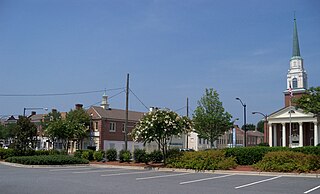
Kannapolis (Kŭh-nă-pŭh-lŭs) is a city in Cabarrus and Rowan counties, in the U.S. state of North Carolina, northwest of Concord and northeast of Charlotte and is a suburb in the Charlotte metropolitan area. The city of Kannapolis was incorporated in 1984. The population was 42,625 at the 2010 census, which makes Kannapolis the 20th largest city in North Carolina. It is the home of the Kannapolis Intimidators, the Class A baseball affiliate of the Chicago White Sox, and it is the hometown of the Earnhardt racing family. The center of the city is home to the North Carolina Research Campus, a public-private venture that focuses on food, nutrition, and biotech research.

Midland is a town in southern Cabarrus County in the U.S. state of North Carolina. Located in the Charlotte region of North Carolina, Midland is a 30-minute commute to uptown Charlotte. The name of the town is derived from its location approximately halfway between Charlotte and Oakboro on the railroad line. As of July, 2014, the town population was 3,507.

Bynum is an unincorporated community in northeastern Chatham County, North Carolina, United States on the banks of the Haw River. Bynum is 5 miles north of Pittsboro, North Carolina and 11 miles south of Chapel Hill, North Carolina. It is also known as Bynum Mill Village or Bynum Mill Hill.

Cabarrus County Schools is a local education agency headquartered in Concord, North Carolina. The system presides over the vast majority of Cabarrus County, North Carolina, the exception being an area of Kannapolis in the northern part of the county that operates its own district. Over 32,000 students are enrolled in Cabarrus County Schools, and the school system employs over 2200 teachers. The current superintendent is Dr. Chris Lowder. The previous superintendent, Dr. Barry Shepherd, retired April 1, 2015.
Concord High School is a public high school in Concord, North Carolina, United States. First opened on September 2, 1895, it is the oldest public high school in Cabarrus County and one of the oldest extant in North Carolina. It became part of Cabarrus County Schools in 1983 when Concord City Schools merged with the county school system. It is also a half regular high school and half IB high school

Odell School is an unincorporated community in northwestern Cabarrus County, North Carolina, United States, named for W. R. Odell Elementary School, a part of the Cabarrus County Schools system. It lies between Huntersville and Concord.

The Cannon Mills Company was an American textile company founded by James William Cannon, based in Kannapolis, North Carolina. It was founded in 1888 and went bankrupt in July 2003. The Cannon brands were then purchased by the Iconix Brand Group.
Thomas Franklin Lloyd is one of the founders of Carrboro, North Carolina. He was a prominent North Carolina industrialist who built the Alberta Cotton Mill in 1898 in Carrboro; the former factory building is now home to the Carr Mill Mall.

The Coleman Manufacturing Company (1899–1904) had the first cotton mill in the United States owned and operated by African Americans. Organized in 1897 by Warren Clay Coleman and others, and operating under original leadership until 1904, it was located in the Piedmont area about two miles from the county seat of Concord, North Carolina in Cabarrus County. Textile manufacturing had been established here before the American Civil War, but the mills hired only white industrial workers. The Coleman property later became part of Franklin Cotton Mills and a Fieldcrest Cannon plant.

The historic Cabarrus County Courthouse, on Union St., S., in Concord, North Carolina, was completed in 1876, replacing one that was destroyed by fire just the previous year. It was designed by architect G.S.H. Appleget. It includes Second Empire, Italianate, Classical Revival, and other architecture. It was listed on the National Register of Historic Places in 1974. The courthouse is now the home of the Cabarrus County Veterans Museum. It is located in the South Union Street Courthouse and Commercial Historic District.

Dunavant Cotton Manufacturing Company, also known as Alpine Cotton Mill No. 1, is a historic cotton mill located at Morganton, Burke County, North Carolina. It is a two-story, brick-clad, side gable-roofed building. The original section was built in 1888-1910, with additions and expansions through 1966. The additions to the building, made in the mid to late 1960s were removed in 2012 to reveal the original 1888-1910 mill building. It is the oldest cotton textile mill in Morganton, and was in use as a cotton textile mill until 1949.

South Union Street Courthouse and Commercial Historic District is a national historic district located at Concord, Cabarrus County, North Carolina. The district encompasses 11 contributing buildings in the central business district of Concord. It primarily includes commercial buildings in popular architectural styles including Italianate, Romanesque Revival, and Second Empire style architecture. Located in the district are the Elks Hall, former Town Hall, G. W. Patterson Wholesale Grocery, Pythian Building, Watch Repair Shop, and former Cabarrus Savings Bank (1923-1924). Also in the district is the separately listed former Cabarrus County Courthouse.

Union Street North–Cabarrus Avenue Commercial Historic District is a national historic district located at Concord, Cabarrus County, North Carolina. The district encompasses 14 contributing buildings in the central business district of Concord. It primarily includes commercial buildings in popular architectural styles including Beaux-Arts style architecture. Located in the district are the Bell and Harris-Maxwell Brothers Furniture Store (1921–1924), Yorke and Wadsworth Company Warehouse (1908–1911), Lippard and Barrier Grocery (1908–1911), Concord National Bank and Hotel Concord (1926), Star Theatre, Cannon Building and Concord Theatre, and Horton Building–Commerce and Merchants Building (1952).

Bost Mill Historic District is a national historic district located near Georgeville, Cabarrus County, North Carolina. The district encompasses 10 contributing buildings and 3 contributing sites associated with the Bost Mill grain and cotton operation. Notable buildings include the Bost Roller Mill, the John Bost House with its five outbuildings, the Bost Tenant House, the St. Paul's Methodist Church, and the Bost Cotton Gin.

Mount Pleasant Historic District is a national historic district located at Mount Pleasant, Cabarrus County, North Carolina. The district encompasses 98 contributing buildings and 3 contributing structures in the town of Mount Pleasant. It includes residential, institutional, and commercial buildings in a variety of popular architectural styles including Victorian, Colonial Revival, and Bungalow / American Craftsman. Notable buildings include the Jacob Ludwig House, Kindley Mill Village houses, Saint James Evangelical and Reformed Church, Lutheran Church of the Holy Trinity, Mount Pleasant Milling Company, Kindley Cotton Mill, and Tuscarora Cotton Mill.

Deep River-Columbia Manufacturing Company was a historic textile mill complex located at Ramseur, Randolph County, North Carolina. The brick mill complex was built between about 1850 and 1920. The main mill building consisted of a two-story, 11-bay, gable-roofed section built about 1850, with a three-story, 13-bay addition constructed in 1888. A four-story stair tower was added to the mill between 1885 and 1888. The mill closed in January 1963. It has been demolished.

The Coleman-Franklin-Cannon Mill is a historic industrial complex at 625 Main Street SW in Concord, North Carolina. The recognized complex consists of ten buildings on 6.6 acres (2.7 ha), about 2 miles (3.2 km) west of downtown Concord. Another 4.4 acres are not included. The oldest portion of the mill, now its eastern section, is a brick two-story structure 14 bays long and 9 deep. The historic site also includes some worker housing.

Warren Clay Coleman was an African-American businessman in south-central North Carolina known as a founder of the Coleman Manufacturing Company, which built one of the first black-owned and operated textile mills in the United States. The Coleman-Franklin-Cannon Mill still stands in Concord, North Carolina, and was listed on the National Register of Historic Places in 2015.


















